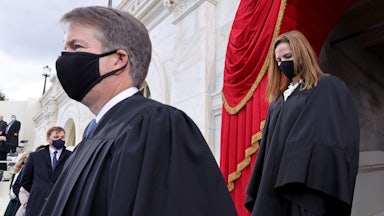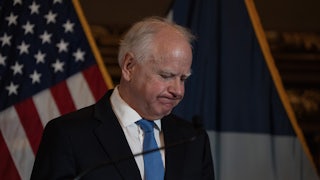The Supreme Court did not overturn Roe v. Wade outright in its ruling in Whole Woman’s Health v. Jackson on Wednesday night. But the outcome will be all but indistinguishable for women in Texas, where virtually all abortions are now legally impossible to perform. In a late-night order, five justices from the court’s conservative majority rejected a bid by Texas abortion providers to enjoin Senate Bill 8’s enforcement, citing procedural hurdles that were constructed by Texas to keep the law active.
Since Justices Brett Kavanaugh and Amy Coney Barrett joined the court, legal observers have debated if the entrenched conservative majority would dismantle abortion rights in a more piecemeal fashion or move to overturn Roe outright. The justices will have a chance to explicitly do the latter in Jackson Women’s Health Organization v. Dobbs when they hear that case this fall. After Wednesday night, however, it’s all but impossible to imagine that Roe v. Wade—and abortion rights for millions of American women—will survive the upcoming Supreme Court term.
We can start by stating the obvious: Texas passed S.B. 8 to make it virtually impossible to obtain an abortion in the state. I say “virtually” because, in theory, a woman could still obtain one if she happens to be less than six weeks pregnant at the time. But since this is before many women realize they are pregnant, the practical effect of S.B. 8 is a near-total ban on the procedure within Texas. In a brief earlier this week, a coalition of abortion providers told the justices that S.B. 8 would “immediately and irreparably decimate abortion access in Texas, barring care for at least 85 percent of Texas abortion patients (those who are six weeks pregnant or greater) and likely forcing many abortion clinics to ultimately close.”
Banning pre-viability abortions is a blatant violation of Roe and the line of abortion rights cases that followed it. States are not generally allowed to violate the Supreme Court’s precedents. To get around this, Texas lawmakers structured the law to make it exceedingly difficult for federal courts to hear a legal challenge to the statute. If S.B. 8 were enforced by Texas health regulators or Texas law enforcement agencies, a clinic could simply ask a federal court to enjoin those officials under Section 1983, a Reconstruction-era provision that allows Americans to sue state and local officials for violating their constitutional rights.
Texas tried something different: It allows private citizens—even random strangers—to file lawsuits in Texas state courts against anyone who performs an abortion after the six-week threshold or anyone who “aids or abets” such an abortion. The latter provision is written so broadly that it could sweep up all sorts of individuals who are tangentially involved, ranging from family members and Uber drivers to health insurers and clinic staffers. If the lawsuit is successful, two things happen: The person is enjoined from such “aiding and abetting” again in the future, and they must pay at least $10,000 to whoever filed the lawsuit.
The law’s defenders are careful to note that S.B. 8 can’t be used to sue a woman herself for obtaining an abortion, as if the women should be grateful for not adding insult to injury. They also point out that S.B. 8 does not allow men who impregnated the woman through rape or incest to file such a lawsuit, even though other strangers remain free to use litigation to force women to carry their pregnancies to term. “It’s not as cruel as it could be” is a defense that could only be made in a state where lawmakers go out of their way to insulate themselves from electoral consequences.
Even the majority in Wednesday night’s ruling implicitly acknowledged that S.B. 8 is designed to flout Roe. “The applicants now before us have raised serious questions regarding the constitutionality of the Texas law at issue,” the majority wrote in an unsigned order. “But their application also presents complex and novel antecedent procedural questions on which they have not carried their burden.” The Texas abortion providers had sued a broad array of Texas officials, including a county judge and a county court clerk, in their bid to stop the law from taking effect.
“For example, federal courts enjoy the power to enjoin individuals tasked with enforcing laws, not the laws themselves,” the majority went on to explain. “And it is unclear whether the named defendants in this lawsuit can or will seek to enforce the Texas law against the applicants in a manner that might permit our intervention. The state has represented that neither it nor its executive employees possess the authority to enforce the Texas law either directly or indirectly. Nor is it clear whether, under existing precedent, this Court can issue an injunction against state judges asked to decide a lawsuit under Texas’s law.”
You might notice that the majority noted at multiple points that existing precedent is “unclear” on the legality here. If this were a fully briefed and argued case, the justices would be more obligated to make clear about the law what is currently unclear about it. But when considering an emergency request for a stay or injunction on the court’s “shadow docket,” the majority can claim not to resolve these questions in theory while actually resolving them in practice.
It’s unsurprising that at least one of the dissenters, Justice Elena Kagan, pointed out how the shadow docket warped the outcome. “That ruling, as everyone must agree, is of great consequence,” she wrote. “Yet the majority has acted without any guidance from the [Fifth Circuit] Court of Appeals—which is right now considering the same issues. It has reviewed only the most cursory party submissions, and then only hastily. And it barely bothers to explain its conclusion—that a challenge to an obviously unconstitutional abortion regulation backed by a wholly unprecedented enforcement scheme is unlikely to prevail.”
How you ultimately read this decision depends on how much good faith you are willing to extend to the five justices who voted for it. If you believe the majority is sincerely guided by a rigorous commitment to federal procedure, then the ruling is more defensible. The majority, after all, tried to underscore that it wasn’t delivering a final judgment on S.B. 8’s constitutionality. “In reaching this conclusion, we stress that we do not purport to resolve definitively any jurisdictional or substantive claim in the applicants’ lawsuit,” they claimed. “In particular, this order is not based on any conclusion about the constitutionality of Texas’s law, and in no way limits other procedurally proper challenges to the Texas law, including in Texas state courts.”
If you think the justices weren’t born yesterday, however, then their decision is a little harder to defend on its own merits. S.B. 8 is plainly designed to wipe out access to abortion in Texas while making it procedurally tricky for federal courts to strike it down for violating Roe. “The legislature has imposed a prohibition on abortions after roughly six weeks, and then essentially delegated enforcement of that prohibition to the populace at large,” Chief Justice John Roberts ably summarized in his brief dissent. “The desired consequence appears to be to insulate the State from responsibility for implementing and enforcing the regulatory regime.”
Once you acknowledge this context, the logical conclusion flows naturally. “I would grant preliminary relief to preserve the status quo ante—before the law went into effect—so that the courts may consider whether a state can avoid responsibility for its laws in such a manner,” Roberts concluded. He added that the state officials may yet prevail on their procedural claims. “But the consequences of approving the state action, both in this particular case and as a model for action in other areas, counsel at least preliminary judicial consideration before the program devised by the State takes effect,” he explained. Roberts’s concern that S.B. 8’s evasive tactics could become a new normal even in nonabortion cases is palpable, and hopefully shared by his colleagues.
The court’s liberals cut to the heart of the matter even more efficiently. “I recognize that Texas’s law delegates the state’s power to prevent abortions not to one person (such as a district attorney) or to a few persons (such as a group of government officials or private citizens) but to any person,” Justice Stephen Breyer wrote in a separate dissent. “But I do not see why that fact should make a critical legal difference. That delegation still threatens to invade a constitutional right, and the coming into effect of that delegation still threatens imminent harm.” Accordingly, rather than untangle the Texas legislature’s Gordian knot, he would have simply cut through it.
Justice Sonia Sotomayor, in an even more sharply worded dissent, argued that the court should have granted the injunction out of self-respect for its own precedents in addition to the underlying context. “By prohibiting state officers from enforcing the Act directly and relying instead on citizen bounty hunters, the Legislature sought to make it more complicated for federal courts to enjoin the Act on a statewide basis,” she wrote. “Taken together, the Act is a breathtaking act of defiance—of the Constitution, of this court’s precedents, and of the rights of women seeking abortions throughout Texas.”
As of Thursday morning, it’s only partially accurate to say that Roe v. Wade is the law of the land. Like any other Supreme Court precedent, it remains binding on lower courts until the justices explicitly say otherwise. The conservative majority did not go quite that far in its order in Whole Woman’s Health v. Jackson. But on Wednesday night it moved far closer to that goal, one held by the conservative legal movement and anti-abortion activists for the last five decades. Roe v. Wade is no longer truly the law of the land in Texas—and, barring what would be the greatest surprise in the history of American constitutional law in Dobbs, it will no longer be the law of the land by this time next year.








